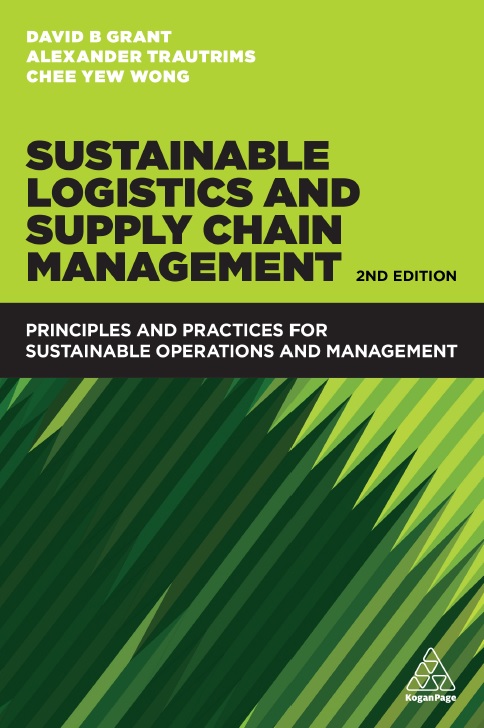by David B Grant, Alexander Trautrims and Chee Yew Wong

CONTENTS
About the authors xi
Foreword by James R Stock xiii
Introduction 1
01 Logistics and supply chain management 8
David B Grant
The nature of logistics and supply chain management 8
Logistics and SCM trends affecting sustainability 12
Sustainable logistics and supply chains 22
Summary 33
References 34
02 Science of sustainability 37
David B Grant
Concepts of sustainability 37
Species and ecosystems 39
Energy 44
Industry 49
Food 53
Population and urban growth 57
Water 59
Summary 61
References 62
03 Freight transport 65
Alexander Trautrims
Impact of freight transport 65
Transport modes 67
Strategies to reduce environmental impact of freight transport 73
Wider aspects of sustainability in freight transport 87
Summary 88
References 89
04 Sustainable warehousing 92
Alexander Trautrims
The environmental impact of warehouses 92
The roles and functions of warehouses 93
Warehouse location 95
Handling equipment 96
Assessing the impact 97
Reduction of environmental impact 101
Social dimension of sustainability in warehousing 110
Risks and vulnerability in warehousing 112
Summary 115
References 115
05 Product design, cleaner production and packaging 119
Chee Yew Wong
Background 119
Product design for environmental and sustainable logistics 121
Selection of materials 123
Cleaner production 129
Packaging for the environment 139
Sustainable consumption and logistics 143
Regulatory frameworks 146
Summary 151
References 152
06 Sustainable purchasing and procurement 155
Alexander Trautrims
The role of procurement in the supply chain 156
What is sustainable procurement? 158
Drivers and barriers for sustainable procurement 161
Procurement frameworks 165
Sustainability labels and certifications 166
Lifecycle assessment 170
Comparing purchasing options 174
Summary 175
References 176
07 Reverse logistics and recycling 179
Chee Yew Wong
Background 179
Circular economy and regulations 181
Product recovery options 186
Reverse logistics 196
Recycling 201
Summary 207
References 207
08 Risk, resilience and corporate social responsibility 211
Chee Yew Wong
Background 211
Risk and resiliency in logistics and supply chains 212
Corporate social responsibility 228
Ethical framework and codes of conduct 235
Global and industrial initiatives 241
Summary 246
References 247
09 Sustainable logistics and supply chain management
strategy 251
David B Grant
Concepts of corporate strategy 251
Theoretical motivations underlying corporate and sustainable
strategy 256
Sustainable logistics and supply chain performance
measurement 261
Environmental management systems 262
Lifecycle assessment 265
Assessing sustainable choices and initiatives 268
Summary 275
References 276
Index 279
Introduction
This second edition of our book discusses sustainability issues pertaining to logistics and supply chain management (SCM), and is different from other books as it takes a holistic view across the supply chain from point of origin through point of consumption and back within the reverse logistics chain.
Logistics and supply chain activities permeate almost every aspect of our lives and thus their ability to impact the natural environment is of significant importance. This edition includes updated information and cases, as well as supplementary materials available at the Kogan Page website.
The objective of this book is to introduce principles and practices that facilitate responsible SCM and sustainable logistics operations in a holistic manner and consider factors of logistics and SCM affecting the natural environment beyond the usual factors of road miles, fuel use and carbon dioxide (CO2) emissions that have been well discussed in freight transportation; see for example Green Logistics: Improving the environmental sustainability of logistics by McKinnon et al (2015), which is a good complement to this book. As an example of wider factors, globalization of business has meant that many products are not manufactured in national markets anymore; they are outsourced and manufactured in lesser-developed countries, particularly in Asia, and then shipped all around the world. How then does a national firm ensure sustainability in its global supply chain? Further, most seasonal fresh food such as fruit and vegetables is now available all year round due to sourcing in foreign markets or the use of sophisticated chilled storage and transport to prevent premature spoiling or ageing. So should consumer markets return to more seasonal goods to reduce the effects on the environment of continuous product availability?
The development of these types of activities and factors has increased the effects that logistics and SCM have on the natural environment. Accordingly, logistics and supply chain strategies and operations are discussed in this book in the context of raising awareness of, and shifting an emphasis to, responsible, ethical and sustainable practices. It is important for firms, consumers and societies to do so and be proactive in considering these issues. Otherwise, legislation may emerge to limit the impact of logistics and SCM on the environment, which may be more draconian than these three stakeholders would desire.
For example, the UK government considered and then abandoned a scheme of personal or individual ‘carbon credits’ in 2008 (BBC News, 2008). Under the scheme, individuals would have an annual carbon dioxide (CO2) emission limit for fuel and energy use, which they could only exceed by buying credits in a secondary carbon-trading market from those who were under limit. The scheme was considered more progressive than taxation, as it would redistribute wealth from rich to poor, transparent and easy for everyone to understand, and fair, as everyone would get the same annual CO2 limit. However, the government’s initial studies found that the cost of introducing the scheme would be between £700 million and £2 billion, plus a further £1–2 billion a year to operate. There were also practical difficulties identified in deciding how to set annual limits, taking into account a person’s age, location, health and activities such as business and personal travel. From a different sustainability perspective, many members of parliament admitted that the public were likely to be opposed to the scheme, but urged the government to be courageous in going ahead with it. With a general election less than two years away, the government decided to discontinue further tax-payer-funded research on the scheme while noting that the concept of personal carbon limits and trading had not been completely abandoned.
